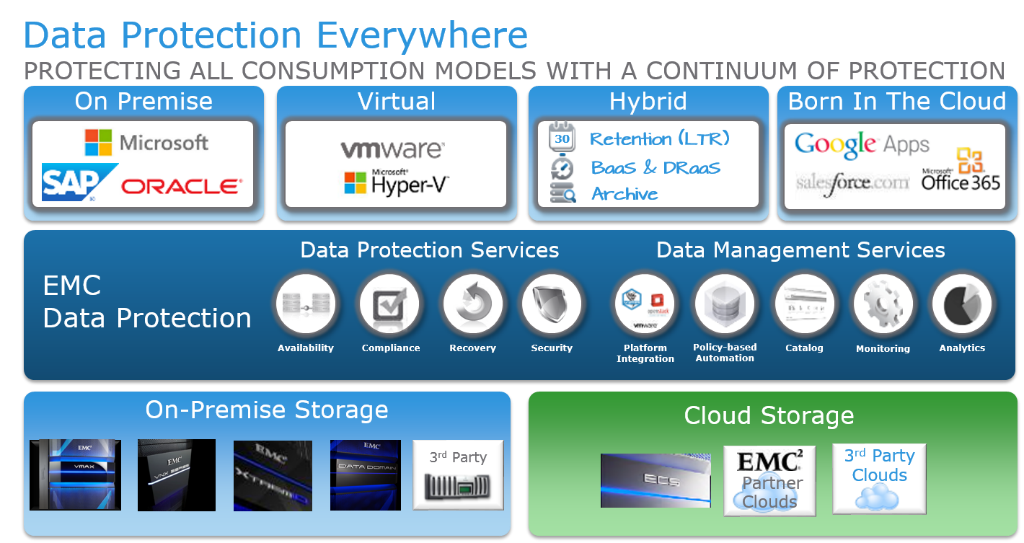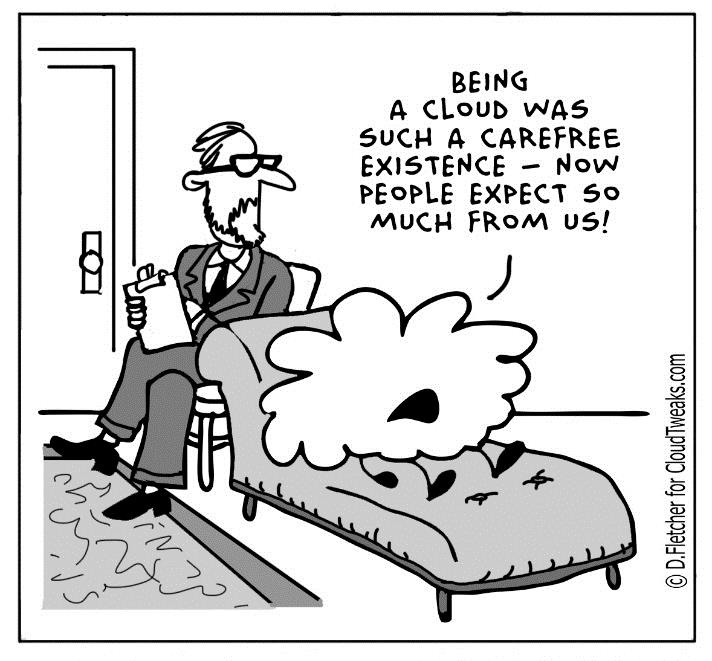 Today’s technology forecast includes an accelerated shift to the hybrid cloud. With over 75% of enterprise IT organizations deploying hybrid cloud already, adoption is predicted to continue to grow. In only the last few years, hybrid cloud has become the preferred way to deliver IT services and drive business transformation. This climate change enables IT to better leverage Public Cloud and Service Providers, delivering new app services with more flexibility and agility. It also helps IT optimize their Private Clouds, delivering traditional app services with more efficiency and trust. In today’s Hybrid Cloud announcement, EMC adds even more across the horizons of the both of these worlds.
Today’s technology forecast includes an accelerated shift to the hybrid cloud. With over 75% of enterprise IT organizations deploying hybrid cloud already, adoption is predicted to continue to grow. In only the last few years, hybrid cloud has become the preferred way to deliver IT services and drive business transformation. This climate change enables IT to better leverage Public Cloud and Service Providers, delivering new app services with more flexibility and agility. It also helps IT optimize their Private Clouds, delivering traditional app services with more efficiency and trust. In today’s Hybrid Cloud announcement, EMC adds even more across the horizons of the both of these worlds.
New capabilities provide more confluence between EMC’s storage and protection technologies, creating the perfect storm to deliver more business value. New automation optimizes Hybrid Cloud efficiency by storing information in the right place at the right costs. New protection capabilities extend data services and provide a path to your trusted Hybrid Cloud. The convergence between storage and protection eliminates silos to boost service levels with the right mix of cost, performance, availability, replication, backup and archive.
Here’s how… and maybe more importantly… WHY it matters.
 On the Storage side, enhancements to VMAX3 FAST.X and Cloud Array make placement and movement of information within a Hybrid Cloud automated and transparent. Inactive data can be moved to an external cloud to lower costs while data remains accessible. It can provide resource elasticity to service storage spikes, providing oversubscription headroom. And it allows workloads to move back and forth between VMAX storage and cloud storage with a simple click to support projects and tests.
On the Storage side, enhancements to VMAX3 FAST.X and Cloud Array make placement and movement of information within a Hybrid Cloud automated and transparent. Inactive data can be moved to an external cloud to lower costs while data remains accessible. It can provide resource elasticity to service storage spikes, providing oversubscription headroom. And it allows workloads to move back and forth between VMAX storage and cloud storage with a simple click to support projects and tests.
Under the covers, Cloud Array is included in the same storage resource pool as other VMAX3 storage tiers and FAST.X connected arrays. Using the Service Level Objective management, admins apply an SLO to an app, and the system figures out where to most efficiently place the data. For apps that require moderate performance, data can be moved to an external cloud for low cost. For apps that need a higher SLO, a simple click can change the policy and promote the data to a faster tier, to increase performance. Management of these tiers is abstracted allowing admins achieve the desired SLO without being exposed to the complexity under the covers. Very cool stuff for the folks who manage multiple storage arrays.
On the Protection side, new capabilities protect your data wherever it resides –Private, Public, or Hybrid Cloud. IT can deliver the right service level by leveraging a continuum of protection services, from availability to backup to archiving. Here are some of the cool highlights.
Cloud Boost 2.0 delivers better performance, management, and flexibility to backup using a choice of Cloud providers, including EMC, Google, Azure, and Amazon. Improved compression doubles efficiency, reducing bandwidth and capacity requirements, lowering costs. New data cache speeds up backup and restore operations, improving RTO’s and RPO’s. And bandwidth optimizations and tuning deliver greater network throughput to the cloud with consistent, predictable performance. For backup admins, these capabilities address real pain points that have made using cloud providers as a backup target an unrealistic option.
Data Domain 5.7 introduces secure multi-tenancy updates combined with capacity reporting. And for those ever growing backups, a higher density shelf provides 33% more system capacity. Network isolation enables secure tenant admin access by specifying IP addresses to restrict access. The combination enables self-service reporting and monitoring by tenant admins and users. With DD 5.7, IT organizations can become more like internal service providers by offering better visibility into what users are consuming, and how much it actually costs.
EMC Data Protection Suite for Backup and for Archive delivers the bow that wraps up a complete packaged solution for end-to-end protection and archive. NetWorker 9’s new universal policy engine automates and simplifies protection regardless of where your data resides. Under the covers, a policy engine automates movement of protection data through tiers of storage. Protected data can be local for immediate access while cold data can be handed off to cost-efficient cloud targets.
In addition, new common services provide improved integration. DP Search, unified with Avamar and NetWorker, now supports metadata and text indexing of filesystem and NDMP backups. What makes DP Search slick is how it enables new insight and business value from backup data. Combined with CloudBoost with NetWorker and Avamar as a cloud storage tier, it offers a way to replace tape for long term retention using a flexible and reliable cloud storage option.
 Going forward, users can expect EMC storage and protection services to continue to become more integrated with their Hybrid Cloud. While there’s a ton on new capabilities here today, rest assured, the forecast is for more innovation.
Going forward, users can expect EMC storage and protection services to continue to become more integrated with their Hybrid Cloud. While there’s a ton on new capabilities here today, rest assured, the forecast is for more innovation.
Hybrid Cloud will transform IT to deliver services with more value to the business. Delivering IT services using Private versus Public Cloud capabilities is no longer an “Or”. For IT, the choices are about the “And”. And many are counting on EMC to deliver on the needs of IT and support that choice – rain and shine.
